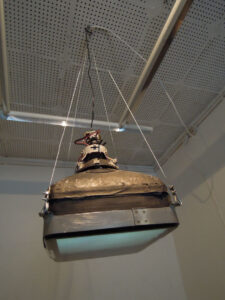Traditionally, every December on Catholic Christmas, the “Borey” gallery presents video projects by media artist Anna Frants. She graduated from the Mukhina School and has lived in Manhattan, New York, for a long time. She is a successful, established person and artist. Following the example of other compatriots abroad, she could have forgotten about her homeland, the city, and those who live here and engage in art, she could have “shaken off the dust from her shoes,” so to speak. But she did not follow this example and did not shake off the dust. Hardly anyone among private individuals has done more to popularize Petersburg’s art than Anya. One of her first projects, conceived with art historian Olga Thomson, was the “Russian Album” website, which collected all the St. Petersburg artists who leaned towards contemporary art at the end of the 20th century. This was followed by the collective project “Moving Objects,” shown as part of the epochal exhibition at the Russian Museum “Abstraction. 20th Century”. Anna Frants organizes exhibitions of St. Petersburg artists in the USA, has collected a collection of modern Russian art. For several years, together with the State Center for Contemporary Art, she has been organizing the significant review of media art “Cyberfest,” which this year took place in the Hermitage.
In New York, Anna Frants organized the Cyland media lab, and the project shown in “Borey” is titled “Visionary Dreams (USA) #3353-3357 by Anna Frants and Cyland Media Lab.” The exhibition at the “Borey” gallery is small: each room features one project, but the format does not exclude artistic quality, elegance of thought expression, or elegance of exposition. In my opinion, the exhibition can be called exemplary – it can be used to learn how to present contemporary art: without any pseudo-baroque “frills” so loved by our people, without moralizing, without politicking, without shocking and low blows, without the desire to tell everything, explain everything, and spend a lot of artistic means on it, lest, God forbid, the viewer doesn’t understand. The project is presented minimalistically, it is a kind of sotto voce conversation because “he who has ears to hear, let him hear,” and he who does not have ears will probably not glance into “Borey.” What’s interesting in this exhibition is that video projections are interconnected with material objects, and thus the problem of exhibition space is solved, and the intangibility of video receives a pleasant material reinforcement, a certain basis, a solid foundation.
In the first room, visitors are greeted by a mysterious film about hands. The video installation is simply named: “Hands.” In the second room, a project titled “Elevator” is presented. Along a crooked rail with a screech moves a video projector, projecting an image of an elevator shaft on the wall. In this video installation, the artist explores the theme of anxiety, familiar to everyone entering an elevator cabin. Whether we like it or not, in the enclosed space of the cabin, similar to a dress closet, we are haunted by fears: we experience claustrophobia – to a greater or lesser extent, we are afraid of being stuck in a confined space for a long time, we fear that some cable will snap and we will plummet down in this closet. So Anna Frants chose a quite objective reason for artistic reflection.
In the smallest room of “Borey,” an old television tube is suspended from the ceiling. There are no images on the screen; it emits a faint glow. The artist herself comments on this installation as follows: “Two incompatible technologies are combined: analog and digital. A pixel descends across the screen of an old television tube. It seems to be subject to gravity, the same force that acts on the tube itself, which does not fall only because it is suspended from the ceiling. In this case, the outdated, bulky, and ultra-modern elements are subject to the same law as Newton’s apple.” This installation is very beautiful. The suspended tube, covered with a compound like paint, resembling brown skin or rust-touched metal, first of all reminds one of an old lamp under a lampshade, hanging over the dining table in an old St. Petersburg apartment.
In the last installation, located in the farthest room, the artist used the motif of jumping acrobats by Eadweard Muybridge. Overall, the exhibition leaves a good aesthetic aftertaste and a feeling of immersion in silence and mystery, aptly named “Visualization of a Dream.”
S. Azarkhi
December 27th, 2011
www.artclubspb.ru / web.archive.org

